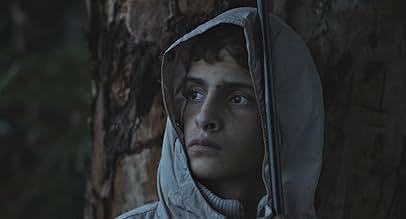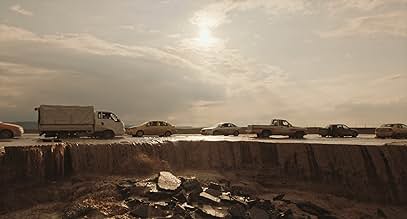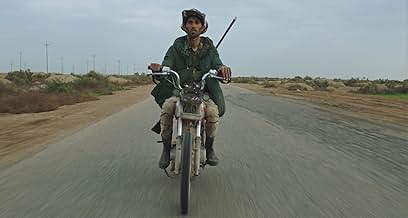AVALIAÇÃO DA IMDb
6,6/10
1,4 mil
SUA AVALIAÇÃO
Um documentário sobre aqueles que tentam sobreviver no Oriente Médio devastado pela guerra.Um documentário sobre aqueles que tentam sobreviver no Oriente Médio devastado pela guerra.Um documentário sobre aqueles que tentam sobreviver no Oriente Médio devastado pela guerra.
- Direção
- Roteirista
- Prêmios
- 7 vitórias e 15 indicações no total
Avaliações em destaque
There are some scenes in this world that are just sitting still, awaiting for a person with a camera at hand to arrive and film, and the war-stricken fields and streets of Syria, Lebanon and Iraq undeniably fall into that category. Fortunately Gianfranco Rosi resolved to be that person with his skillfully placed cameram just letting those streets and fields tell the tale.
The film consists of several parallel sotries of people, remnants, survivors and soldiers moving simultaneously along. We are shown a boy maybe of 10 years try to survive by working dawn to dusk for mere five dollars, a group of women-soldiers guarding the borders who might just be some college student party-goers if they had more share of luck when born, a mental health ward of a hospital with a doctor and a crew of mentally-shaken patients and a group of kids with fallen parents living a life not identical to ours.
But the film- or the scenes- doesn't show these people as victims to be pitied or sympathized, but as alive and sentient humans trying their best to maintain thier poise and outplay thier unfortunate circumstances and that is the most moving part of this film.
the other very bold and stroking aspect of Rosi's work is how gorgeous and stunning it looks. The landscape shots are plenty and here and there are vistas so catchy that reminds us of this region's old glories. I had the chance to watch this work on silver screen and I think it it best served that way.
The film consists of several parallel sotries of people, remnants, survivors and soldiers moving simultaneously along. We are shown a boy maybe of 10 years try to survive by working dawn to dusk for mere five dollars, a group of women-soldiers guarding the borders who might just be some college student party-goers if they had more share of luck when born, a mental health ward of a hospital with a doctor and a crew of mentally-shaken patients and a group of kids with fallen parents living a life not identical to ours.
But the film- or the scenes- doesn't show these people as victims to be pitied or sympathized, but as alive and sentient humans trying their best to maintain thier poise and outplay thier unfortunate circumstances and that is the most moving part of this film.
the other very bold and stroking aspect of Rosi's work is how gorgeous and stunning it looks. The landscape shots are plenty and here and there are vistas so catchy that reminds us of this region's old glories. I had the chance to watch this work on silver screen and I think it it best served that way.
This movie sucks it's so boring. I could've done a better documentary with my android phone.
Several years ago, Gianfranco Rosi lectured to an audience of university students (myself included) about his next project: it would be filmed exclusively at night, he said, and take place over much of the Middle East. He asked that we not release any of this information - assured of the secret pact with his audience. I had more or less forgotten about this project until recently, when I discovered it had been selected as the Italian entry for the Best International Feature Film at the 93rd Academy Awards, and was being distributed by MUBI.
Notturno ("night," or "of the night") is a collection of brief glimpses into the lives of people across Syria, Lebanon, Iraq and the Kurdistan region of northern Iraq. From dark swamplands to inner cities, fisherman, soldiers and teachers, to name a few, are brought into the documentary's compass. Few words are spoken by those selected, and much of their action or routine takes place in quietness - a sort of calm in the aftermath of a terrible storm. Rosi's observational and distant study only partly takes places at night; many scenes are filmed in the soft glow of dawn or twilight, and many in bright sunlight.
For a while, I was sceptical about the documentary's artistic license. There is near-perfect composition to each frame, and the theatrical recreation of war by the amateur, psychiatric patients reminded me of Joshua Oppenheimer's The Act of Killing (where civilians and dictators are made to dramatise the traumas of their past). And yet, I found myself compelled by Notturno's visual storytelling, by the sparseness of its landscapes and sound. There are stories within these images, and sometimes they need to speak for themselves, without the aid of conventional narration or voiceover.
Notturno ("night," or "of the night") is a collection of brief glimpses into the lives of people across Syria, Lebanon, Iraq and the Kurdistan region of northern Iraq. From dark swamplands to inner cities, fisherman, soldiers and teachers, to name a few, are brought into the documentary's compass. Few words are spoken by those selected, and much of their action or routine takes place in quietness - a sort of calm in the aftermath of a terrible storm. Rosi's observational and distant study only partly takes places at night; many scenes are filmed in the soft glow of dawn or twilight, and many in bright sunlight.
For a while, I was sceptical about the documentary's artistic license. There is near-perfect composition to each frame, and the theatrical recreation of war by the amateur, psychiatric patients reminded me of Joshua Oppenheimer's The Act of Killing (where civilians and dictators are made to dramatise the traumas of their past). And yet, I found myself compelled by Notturno's visual storytelling, by the sparseness of its landscapes and sound. There are stories within these images, and sometimes they need to speak for themselves, without the aid of conventional narration or voiceover.
Nice images without context. These could have been observed anywhere, with or without a war or other threats around. Did I not have similar problems with Fire At Sea / Fuocoammare at Berlinale 2016?? My first thoughts at the time were that I saw nothing new and revolutionary. Other attendees made me doubt, however. The reactions of people around me forced me to re-think what impact such a documentary can have on the average viewer, apparently on them. What did I miss??
I've seen many documentaries around the same topic in 2016/2017, which causes a certain distance and some feeling that all this should be common knowledge already. Still, images like this seem to impress people. Maybe it showcases the term "impressionistic" I see in many reviews, something that I did not understand when explained at school, and still goes above my head nowadays. Viewers knowledgeable about the context seem able to connect the dots when letting these images pass by. I wonder how it would be received by someone who was not told beforehand what the central topic of conversation was.
Some of the images (1/3 as I mentioned before) can be understood without context, like the women mourning in a prison cell, the soldiers jogging/marching at dawn, soldiers surveying the environment from a shelter, stage players practicing their lines (quoting clear texts about the sorry state of their country), school children explaining their drawings, and so on. Those parts really were memorable. The other 2/3 went past me.
I sat it out through the end, but still do not understand the value of this documentary (if any). Maybe I just don't like kaleidoscopic movies, presenting a series of images/scenes that are not related to each other, not telling a story but merely painting an image where we are pressured to connect the dots and understand what the filmmakers try to convey. It is lost on me, in any case. Another explanation can be that I saw so many documentaries (part of IDFA, Movies That Matter, and other festivals) that are so much more illuminating and compelling, that this one in comparison does very little to pique my interest. It tells nothing new, and just repeats the obvious in a slightly different way but not adding any value. Leaves us with the nice images.
I've seen many documentaries around the same topic in 2016/2017, which causes a certain distance and some feeling that all this should be common knowledge already. Still, images like this seem to impress people. Maybe it showcases the term "impressionistic" I see in many reviews, something that I did not understand when explained at school, and still goes above my head nowadays. Viewers knowledgeable about the context seem able to connect the dots when letting these images pass by. I wonder how it would be received by someone who was not told beforehand what the central topic of conversation was.
Some of the images (1/3 as I mentioned before) can be understood without context, like the women mourning in a prison cell, the soldiers jogging/marching at dawn, soldiers surveying the environment from a shelter, stage players practicing their lines (quoting clear texts about the sorry state of their country), school children explaining their drawings, and so on. Those parts really were memorable. The other 2/3 went past me.
I sat it out through the end, but still do not understand the value of this documentary (if any). Maybe I just don't like kaleidoscopic movies, presenting a series of images/scenes that are not related to each other, not telling a story but merely painting an image where we are pressured to connect the dots and understand what the filmmakers try to convey. It is lost on me, in any case. Another explanation can be that I saw so many documentaries (part of IDFA, Movies That Matter, and other festivals) that are so much more illuminating and compelling, that this one in comparison does very little to pique my interest. It tells nothing new, and just repeats the obvious in a slightly different way but not adding any value. Leaves us with the nice images.
Though the fim begins with an introductory text on the modern history of the Middle-East, it focuses on specific scenes and people at the seeming end to the current phase of the conflicts. Some scenes depict the mundane day to day existence of the wars, while in others people are trying to reconcile what they have experienced through art. There is also an element of the environment in how the wars effect nature itself. Though sad in essence, the visuals of the film are stunning and immersive.
Você sabia?
- CuriosidadesOfficial submission of Italy for the 'Best International Feature Film' category of the 93rd Academy Awards in 2021.
- Citações
Teacher: Tell me what you saw.
Principais escolhas
Faça login para avaliar e ver a lista de recomendações personalizadas
- How long is Notturno?Fornecido pela Alexa
Detalhes
Bilheteria
- Faturamento bruto mundial
- US$ 121.053
- Tempo de duração
- 1 h 40 min(100 min)
- Cor
- Proporção
- 1.85 : 1
Contribua para esta página
Sugerir uma alteração ou adicionar conteúdo ausente


![Trailer [OV]](https://m.media-amazon.com/images/M/MV5BNzY2YTkyZGQtOWYwOS00MDRhLWEyZDctNWU0MGE2YzdmOGEwXkEyXkFqcGdeQXRyYW5zY29kZS13b3JrZmxvdw@@._V1_QL75_UX500_CR0)


















